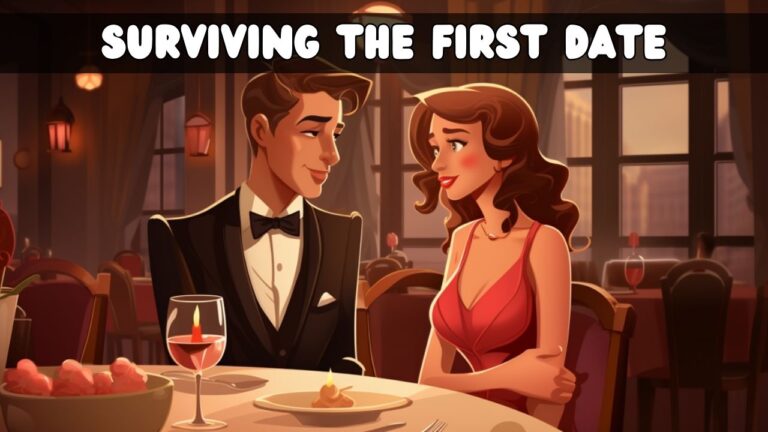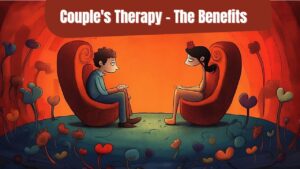
Surviving the First Date: A No-Nonsense Guide
Embarking on the journey of a first date can be an exhilarating yet nerve-wracking experience. It’s akin to launching a ship onto uncharted waters, not entirely sure of what to expect but filled with hope for what lies ahead. Two essential elements often dictate the success and tone of this pivotal meeting: the lasting power of first impressions and the foundational tone it sets for potential future encounters.
The Importance of the First Impression
It’s often said that you don’t get a second chance to make a first impression. This adage holds particularly true for first dates. Within mere moments of meeting, subconscious judgments and perceptions start to form. Elements ranging from your attire, punctuality, to the initial greeting play integral roles in setting the stage. This immediate snapshot can hold a significant influence over the date’s trajectory and even potential future meetings. It’s not just about putting on a facade; it’s about presenting an authentic yet polished version of oneself, radiating confidence and genuine interest.
Setting the Tone for Future Encounters
A first date is more than just a standalone event; it’s a precursor, a potential prologue to a series of future dates or interactions. The nuances of your conversation, the respect displayed, and even the humor shared can serve as key indicators of compatibility. Establishing a positive, comfortable atmosphere isn’t solely about ensuring a successful first date—it’s about leaving the door ajar for future opportunities. Whether it culminates in a blossoming relationship or just a newfound friendship, setting the right tone can lead to enriching experiences down the line.
Navigating the maze of first-date dynamics can be challenging, but with a few key strategies, one can turn this daunting task into a delightful adventure. Join Dr. Hart as she delves deeper into the world of first dates, providing expert guidance every step of the way.
Choosing the Perfect Setting

Selecting the ideal location for a first date isn’t just about choosing a place; it’s about crafting an environment conducive to meaningful connection, comfort, and discovery. The backdrop of your date can either serve as a supporting character, enhancing the narrative, or an unwanted distraction that detracts from the budding connection. Below, Dr. Hart shares some invaluable insights to aid in this all-important decision.
Considering Mutual Interests
When pondering potential venues, it’s crucial to lean into mutual interests. Did both of you express an affinity for art? Perhaps a local art gallery or a museum might serve as an engaging backdrop. Are you both nature enthusiasts? A serene botanical garden walk might just be the ticket. By selecting a location based on shared passions or curiosities, the date instantly becomes more personal and tailored. It not only provides natural conversation starters but also demonstrates a thoughtful approach, highlighting that you’ve paid attention during prior interactions or chats.
Avoiding Overly Romantic or Intimate Venues
While romance might be the overarching goal for many first dates, it’s often wise to steer clear of settings that lean too heavily into intimacy right from the get-go. Candle-lit private dinners, secluded beach walks, or intimate home-cooked meals might seem like dreamy ideas, but they can unintentionally pile on the pressure. Such settings can, at times, create an expectation-laden atmosphere, making one or both parties feel they need to live up to the heightened romantic scene. Instead, aim for a balanced ambiance that allows romance to develop organically, without feeling orchestrated.
The Merits of Public and Casual Settings
There’s a comforting reassurance in public and casual settings, especially for a first date. Cafés, bustling parks, local fairs, or even interactive activities like mini-golf or pottery classes can be excellent choices. These environments naturally alleviate some of the tension that can come with one-on-one encounters in more secluded or formal settings. The casual vibe often fosters more relaxed conversations, allowing personalities to shine through without the constraints of a rigid setting. Moreover, public spaces offer a sense of security, ensuring both parties feel at ease.
In essence, the goal is to create a setting where both individuals feel safe, relaxed, and free to be themselves, allowing the nascent bond to flourish.
Breaking the Ice: Conversation Starters

A well-timed question or topic can turn an awkward silence into a meaningful conversation. The art of initiating engaging dialogue lies in striking the right balance between being interesting without being too invasive. Dr. Hart offers some techniques and topics to ease into the flow of conversation, setting the foundation for a memorable encounter.
Safe and Neutral Topics to Begin With
Starting with universally relatable and neutral topics can help both parties ease into the conversation. Here are some suggestions:
- Travel and Destinations: “Have you been on any exciting trips lately?” or “Is there a dream destination you’d love to visit?”
- Hobbies and Interests: “How do you like to spend your weekends?” or “Do you have any hobbies or activities you’re passionate about?”
- Books, Movies, and Music: “Have you read any good books or seen any great movies recently?” or “Do you have a go-to genre or artist you listen to?”
- Current Events: Discussing a recent uplifting news story or a popular cultural event can be a great way to gauge each other’s perspectives. However, be cautious to avoid polarizing topics like politics unless you’re both comfortable diving into deeper waters.
Using Open-ended Questions
The difference between a fleeting chat and a profound conversation often lies in the nature of the questions posed. Open-ended questions are designed to elicit more than just a ‘yes’ or ‘no’ response. They provide the other person with an opportunity to share stories, feelings, or opinions. Questions like:
- “What inspired you to choose your current profession?”
- “How was your experience growing up in [their hometown/city]?”
- “What’s a lesson you’ve learned recently that’s had a significant impact on you?”
These types of inquiries pave the way for deeper connection and understanding.
Listening Actively and Responding Genuinely
While initiating the conversation is essential, how you listen and respond is equally crucial. Active listening involves fully concentrating, understanding, and then responding to what the other person is saying. This means resisting the urge to frame your next question or comment while they’re still talking. By genuinely engaging with their stories or comments, you not only show respect but also foster a sense of trust and sincerity. Follow up on their statements with related questions or share a similar experience, showcasing your genuine interest in getting to know them.
Remember, a successful conversation is a two-way street. By balancing talking with active listening, you’re laying the groundwork for a mutual and meaningful connection.
Mastering Body Language

Body language is a powerful communicator, often speaking volumes more than words ever can. Dr. Hart delves into the nuances of non-verbal cues, helping you navigate the unspoken dynamics of the first date with confidence and insight.
The Do’s and Don’ts: Postures, Gestures, and Facial Expressions
Every gesture, posture, and expression communicates a message, consciously or unconsciously. Here’s a guide to ensure your body speaks in sync with your intentions:
Do’s:
- Open Posture: Sitting or standing with an open posture (not crossing your arms or legs defensively) suggests openness and receptiveness.
- Mirroring: Subtly mimicking the posture or movements of your date can indicate interest and create a sense of connection.
- Smiling: A genuine smile can set a warm, positive tone for the interaction.
Don’ts:
- Fidgeting: Excessive fidgeting can convey nervousness or impatience.
- Checking the Time Frequently: This might give the impression that you’re bored or have better places to be.
- Avoiding Eye Contact: Consistently looking away can make you seem disinterested or dishonest.
Signs of Interest vs. Disinterest
Recognizing and interpreting your date’s body language can provide valuable insights into their feelings:
- Signs of Interest: Leaning in when you speak, frequent nodding, touching their face or hair, and maintaining a consistent eye contact are all indicators of interest.
- Signs of Disinterest: Leaning away, checking their phone often, looking around the room, and maintaining a closed posture are subtle signals that they might not be into the conversation.
The Role of Eye Contact
Eye contact is perhaps one of the most potent tools in the realm of non-verbal communication. When maintained appropriately:
- It Portrays Confidence: Holding someone’s gaze communicates self-assuredness and interest.
- It Creates Connection: Mutual eye contact can foster a sense of intimacy and trust between individuals.
- It Enhances Understanding: Observing your date’s eyes can provide clues about their feelings and reactions.
However, it’s essential to strike a balance. Overly prolonged eye contact can come off as intimidating or invasive, while too little can seem evasive. The key is to listen with your eyes as much as with your ears, using them to enhance understanding and connection.
Ending the Date Gracefully

Every story, no matter how engrossing, must have an end. In the world of dating, how one concludes a date can be as crucial as how it began. Dr. Hart guides you through the art of closing this chapter, ensuring that you leave a lasting, positive impression while keeping doors open for potential future interactions.
Reading the Room: Understanding Your Date’s Cues
Before making any decisions about how to end the date, it’s pivotal to gauge the atmosphere:
- Body Language: As discussed earlier, body language is a potent tool. Is your date leaning in, maintaining eye contact, and laughing at your jokes, or are they looking at their watch, yawning, and maintaining a closed posture?
- Tone of Conversation: An enthusiastic, flowing conversation where both parties are actively engaged might indicate interest, while monosyllabic responses and frequent lulls suggest otherwise.
- Shared Plans: If your date mentions something you both should do in the future, it’s a clear sign they are considering a second date.
Graceful Exit Strategies
Whether you feel the date went splendidly or was a bit of a miss, it’s essential to conclude the interaction with grace:
Direct Yet Kind: If you enjoyed the date and see potential for a future meet-up, express your feelings. However, if you didn’t feel a connection, you can say something like, “It was lovely meeting you. Thank you for the evening.”
Offer to Help with the Bill: This gesture shows thoughtfulness and appreciation, regardless of traditional gender roles or expectations.
Confirm Safe Travels Home: Regardless of the date’s outcome, always ensure they’re safely heading home. It’s a sign of care and concern.
The Art of Showing Appreciation without Overcommitment
Finding the balance between showing appreciation and not promising more than you can deliver can be tricky:
- Be Genuine: If you enjoyed the evening and their company, express that sincerely. A simple “I had a great time tonight” goes a long way.
- Avoid Promising Future Dates Unless You Mean It: Instead of saying, “Let’s do this again,” if you’re uncertain, opt for, “I’m glad we got to spend this time together.”
- Thank You Message: Sending a brief thank you message post-date can be a kind gesture, reflecting on a specific moment or joke shared during the date. However, gauge the appropriateness based on how the date went.
Remember, every date is an opportunity to connect, learn, and grow. Whether it leads to a budding relationship or merely an evening’s experience, approaching it with grace, authenticity, and respect ensures positive outcomes for all parties involved.
Post-Date Communication: When and How?

Navigating the labyrinth of post-date communication is a task fraught with uncertainty and doubt. Dr. Hart sheds light on this delicate dance, emphasizing the importance of sincerity and clarity. After all, how you communicate after the first date can significantly influence the trajectory of a budding relationship.
The Timing: Waiting Game vs. Immediate Feedback
Traditional rules suggest playing it cool and waiting a few days before reaching out. However, in our fast-paced digital age, these ‘waiting games’ may be outdated:
- Immediate Feedback: If you genuinely enjoyed the date and felt a connection, there’s no harm in sending a short message expressing your gratitude. A simple, “I had a great time tonight. Thanks for the lovely evening,” can be warmly received.
- Avoid Prolonged Waiting: If you’re interested, waiting too long might send mixed signals, leading the other person to believe you’re not interested.
- Gauge Their Response: If they reply eagerly and with enthusiasm, it’s a positive sign. A delayed or lukewarm response might require a bit more patience or reflection.
Choosing the Right Medium: Text, Call, or In-person?
Different situations call for different mediums, and the medium you choose can also convey your intentions:
- Text Message: Perfect for quick acknowledgments, thanks, or scheduling subsequent dates. It’s non-intrusive and gives the other person time to formulate their response.
- Phone Call: A more personal approach that’s great if you felt a genuine connection and wish to convey earnestness. However, ensure it’s at a convenient time.
- In-Person: Best reserved for more serious conversations, like if you’re unsure about proceeding and wish to discuss feelings face-to-face.
Honesty is the Best Policy: Expressing Feelings without Pressure
Openness and honesty should be the cornerstones of post-date communication:
- Be Direct but Kind: If you’re interested in another date, express that. If not, gently let them know that while you enjoyed their company, you didn’t feel the romantic spark.
- Avoid Leading On: It’s unfair to string someone along if you don’t see a future. It’s better for both parties to know where they stand.
- Express without Pressure: While it’s crucial to be honest about your feelings, ensure your words don’t pressurize the other person into responding in a particular way.
In conclusion, post-date communication is a blend of understanding your feelings, gauging theirs, and ensuring the chosen communication medium and words reflect your sincere intentions. It’s about mutual respect, where both parties feel valued and heard.
Conclusion
Stepping into the vast world of dating can sometimes feel like navigating a minefield. Every step, every word, and every gesture is weighed against a backdrop of hopes, fears, and societal expectations. However, as we peel back the layers, we find that the essence of a successful first date, or any date for that matter, is genuine human connection. Dr. Hart brings us full circle, reminding us to both reflect and anticipate as we embark on our romantic journeys.
Reflecting on the Experience
Post-date, it’s essential to take a moment of solitude and truly reflect on the experience:
- Personal Insights: Ask yourself, “How did I feel? What resonated with me? Were there any red flags?”
- Shared Moments: Reflect on the shared laughter, engaging conversations, and even the awkward pauses. These are the building blocks of a potential relationship.
- Feedback Loop: Every date is a learning experience. Even if it wasn’t a match made in heaven, there’s always a lesson to be gleaned. It could be about your preferences, your boundaries, or even about refining your dating skills.
Preparation Meets Opportunity: Setting up for Success
The age-old adage says, “Luck is what happens when preparation meets opportunity.” This sentiment rings especially true in the realm of dating:
- Informed Choices: From choosing the perfect setting to mastering non-verbal cues, every piece of advice from this guide equips you to make informed choices, elevating your dating game.
- Building Confidence: Knowing you’re prepared can significantly boost your confidence. And confidence, as many would attest, is attractive!
- Embrace the Unexpected: While it’s great to be prepared, there’s beauty in spontaneity. So, while you arm yourself with knowledge and tips, remember to leave some room for the unexpected joys that dating can bring.
In the grand tapestry of life, first dates are but a single stitch. Yet, they hold the potential to be the start of something beautiful. By equipping yourself with knowledge, understanding, and empathy, you’re not just setting up for a successful date but for a meaningful human connection. Cheers to many more authentic moments and connections!
You may like
Dr. Seraphina Hart, PhD, is a relationship therapist with over two decades of experience in the field of psychology and human behavior. With a rich academic background from Stanford University, she has an in-depth understanding of the complexities of interpersonal relationships. Dr. Hart's journey began with a deep fascination with the human mind and how it forms emotional connections, leading her to specialize in relationship therapy.
Her compassionate approach and unique methodology are informed by her extensive study of various therapeutic modalities, including Cognitive Behavioral Therapy (CBT), Emotionally Focused Therapy (EFT), and mindfulness techniques. Dr. Hart believes in the power of empathy and understanding in healing and transforming relationships. With her guidance, clients learn to navigate their emotions, communicate effectively, and foster a deep sense of self-awareness.






